Loading AI tools
Form of phyletic dwarfism occurring on islands From Wikipedia, the free encyclopedia
Insular dwarfism, a form of phyletic dwarfism,[1] is the process and condition of large animals evolving or having a reduced body size[lower-alpha 1] when their population's range is limited to a small environment, primarily islands. This natural process is distinct from the intentional creation of dwarf breeds, called dwarfing. This process has occurred many times throughout evolutionary history, with examples including various species of dwarf elephants that evolved during the Pleistocene epoch, as well as more ancient examples, such as the dinosaurs Europasaurus and Magyarosaurus. This process, and other "island genetics" artifacts, can occur not only on islands, but also in other situations where an ecosystem is isolated from external resources and breeding. This can include caves, desert oases, isolated valleys and isolated mountains ("sky islands").[citation needed] Insular dwarfism is one aspect of the more general "island effect" or "Foster's rule", which posits that when mainland animals colonize islands, small species tend to evolve larger bodies (island gigantism), and large species tend to evolve smaller bodies. This is itself one aspect of island syndrome, which describes the differences in morphology, ecology, physiology and behaviour of insular species compared to their continental counterparts.
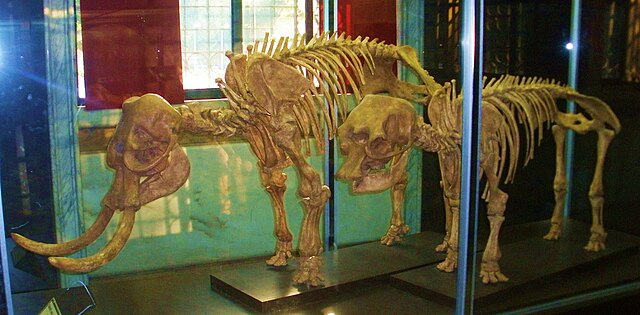
There are several proposed explanations for the mechanism which produces such dwarfism.[3][4]
One is a selective process where only smaller animals trapped on the island survive, as food periodically declines to a borderline level. The smaller animals need fewer resources and smaller territories, and so are more likely to get past the break-point where population decline allows food sources to replenish enough for the survivors to flourish. Smaller size is also advantageous from a reproductive standpoint, as it entails shorter gestation periods and generation times.[3]
In the tropics, small size should make thermoregulation easier.[3]
Among herbivores, large size confers advantages in coping with both competitors and predators, so a reduction or absence of either would facilitate dwarfing; competition appears to be the more important factor.[4]
Among carnivores, the main factor is thought to be the size and availability of prey resources, and competition is believed to be less important.[4] In tiger snakes, insular dwarfism occurs on islands where available prey is restricted to smaller sizes than are normally taken by mainland snakes. Since prey size preference in snakes is generally proportional to body size, small snakes may be better adapted to take small prey.[5]
The inverse process, wherein small animals breeding on isolated islands lacking the predators of large land masses may become much larger than normal, is called island gigantism. An excellent example is the dodo, the ancestors of which were normal-sized pigeons. There are also several species of giant rats, one still extant, that coexisted with both Homo floresiensis and the dwarf stegodonts on Flores.
The process of insular dwarfing can occur relatively rapidly by evolutionary standards. This is in contrast to increases in maximum body size, which are much more gradual. When normalized to generation length, the maximum rate of body mass decrease during insular dwarfing was found to be over 30 times greater than the maximum rate of body mass increase for a ten-fold change in mammals.[6] The disparity is thought to reflect the fact that pedomorphism offers a relatively easy route to evolve smaller adult body size; on the other hand, the evolution of larger maximum body size is likely to be interrupted by the emergence of a series of constraints that must be overcome by evolutionary innovations before the process can continue.[6]
For both herbivores and carnivores, island size, the degree of island isolation and the size of the ancestral continental species appear not to be of major direct importance to the degree of dwarfing.[4] However, when considering only the body masses of recent top herbivores and carnivores, and including data from both continental and island land masses, the body masses of the largest species in a land mass were found to scale to the size of the land mass, with slopes of about 0.5 log(body mass/kg) per log(land area/km2).[7] There were separate regression lines for endothermic top predators, ectothermic top predators, endothermic top herbivores and (on the basis of limited data) ectothermic top herbivores, such that food intake was 7- to 24-fold higher for top herbivores than for top predators, and about the same for endotherms and ectotherms of the same trophic level (this leads to ectotherms being 5 to 16 times heavier than corresponding endotherms).[7]
It has been suggested that for dwarf elephants, competition was an important factor in body size, with islands with competing herbivores having significantly larger dwarf elephants than those where competing herbivores were absent.[8]
Recognition that insular dwarfism could apply to dinosaurs arose through the work of Ferenc Nopcsa, a Hungarian-born aristocrat, adventurer, scholar, and paleontologist. Nopcsa studied Transylvanian dinosaurs intensively, noticing that they were smaller than their cousins elsewhere in the world. For example, he unearthed six-meter-long sauropods, a group of dinosaurs which elsewhere commonly grew to 30 meters or more. Nopcsa deduced that the area where the remains were found was an island, Hațeg Island (now the Haţeg or Hatzeg basin in Romania) during the Mesozoic era.[9][10] Nopcsa's proposal of dinosaur dwarfism on Hațeg Island is today widely accepted after further research confirmed that the remains found are not from juveniles.[11]
| Example | Species | Range | Time frame | Continental relative |
|---|---|---|---|---|
Ampelosaurus | A. atacis | Ibero-Armorican Island | Late Cretaceous / Maastrichtian |  Nemegtosaurids |
 Europasaurus | E. holgeri | Lower Saxony | Late Jurassic / Middle Kimmeridgian |  Brachiosaurs |
 Magyarosaurus | M. dacus | Hateg Island | Late Cretaceous / Maastrichtian |  Rapetosaurus |
 Lirainosaurus[12] | L. astibiae | Ibero-Armorican Island | Late Cretaceous | |
 Paludititan | P. nalatzensis | Hateg Island | Late Cretaceous / Maastrichtian |  Epachthosaurus |
| Example | Species | Range | Time frame | Continental relative |
|---|---|---|---|---|
Langenberg Quarry torvosaur (blue) | Unnamed | Lower Saxony | Late Jurassic / Middle Kimmeridgian | Torvosaurus |
 Struthiosaurus[13] | S. austriacus S. transylvanicus S. languedocensis | Ibero-Armorican, Australoalpine, and Hateg islands | Late Cretaceous |  Edmontonia |
 Telmatosaurus | T. transsylvanicus | Hateg Island | Late Cretaceous | Hadrosaurids |
 Thecodontosaurus[10] | T. antiquus | Southern England | Late Triassic / Rhaetian |  Plateosaurs |
 Zalmoxes[10] (purple) | Z. robustus Z. shqiperorum | Hateg Island | Late Cretaceous |  Tenontosaurus |
In addition, the genus Balaur was initially described as a Velociraptor-sized dromaeosaurid (and in consequence a dubious example of insular dwarfism), but has been since reclassified as a secondarily flightless stem bird, closer to modern birds than Jeholornis (thus actually an example of insular gigantism).
| Example | Binomial name | Native range | Status | Continental relative | Insular / mainland length or mass ratio |
|---|---|---|---|---|---|
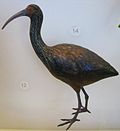 Hawaiian flightless ibises | Apteribis glenos | Molokai | Extinct (Late Quaternary) |  American ibises | |
| Apteribis brevis | Maui | ||||
| Cozumel curassow[14] | Crax rubra griscomi | Cozumel | Unknown |  Great curassow | |
 Kangaroo Island emu[15] | Dromaius novaehollandiae baudinianus | Kangaroo Island, South Australia | Extinct (c. AD 1827) |  Emu | |
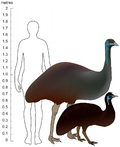 King Island emu[16] (black) | Dromaius novaehollandiae minor | King Island, Tasmania | Extinct (AD 1822) | LR ≈ 0.48 [lower-alpha 2] | |
| Dwarf yellow eyed penguin[17] | Megadyptes antipodes richdalei | Chatham Islands, New Zealand | Extinct (after 1300 AD) |  Yellow-eyed penguin | |
 Cozumel thrasher[14] | Toxostoma gluttatum | Cozumel | Critically endangered |  Other thrashers |
| Example | Binomial name | Native range | Status | Continental relative | Insular / mainland length or mass ratio |
|---|---|---|---|---|---|
 Madagascar dwarf chameleon | Brookesia minima | Nosy Be island, Madagascar | Endangered |  Madagascar leaf chameleons | |
 Nosy Hara chameleon[18] | Brookesia micra | Nosy Hara island, Madagascar | Vulnerable | ||
| Roxby Island tiger snake[5] | Notechis scutatus | Roxby Island, South Australia | Unknown |  Tiger snake | |
| Dwarf Burmese python | Python bivittatus progschai | Java, Bali, Sumbawa and Sulawesi, Indonesia | Unknown |  Burmese python | LR ≈ 0.44 [lower-alpha 3] |
| Tanahjampea reticulated python[21] | Python reticulatus jampeanus | Tanahjampea, between Sulawesi and Flores | Unknown |  Reticulated python | LR ≈ 0.41, males LR ≈ 0.49, females [lower-alpha 4] |
| Example | Binomial name | Native range | Status | Continental relative |
|---|---|---|---|---|
 Pygmy three-toed sloth | Bradypus pygmaeus | Isla Escudo de Veraguas, Panama | Critically endangered |  Brown-throated sloth |
 Acratocnus | A. antillensis A. odontrigonus A. ye | Cuba, Hispaniola and Puerto Rico | Extinct (c. 3000 BC) |  Continental ground sloths |
| Imagocnus | I. zazae | Cuba | Extinct (Early Miocene) | |
 Megalocnus | M. rodens M. zile | Cuba and Hispaniola | Extinct (c. 2700 BC) | |
 Neocnus | Neocnus spp. | Cuba and Hispaniola | Extinct (c. 3000 BC) |
| Example | Binomial name | Native range | Status | Continental relative |
|---|---|---|---|---|
| Sulawesi dwarf elephant | Elephas celebensis | Sulawesi | Extinct (Early Pleistocene) |  Asian elephant |
 Cabarruyan dwarf elephant | Elephas beyeri | Luzon | Extinct | |
 Cretan dwarf mammoth | Mammuthus creticus | Crete | Extinct |  Mammuthus |
 Channel Islands mammoth | Mammuthus exilis | Santa Rosae island | Extinct (Late Pleistocene) | Columbian mammoth |
| Sardinian mammoth | Mammuthus lamarmorai | Sardinia | Extinct (Late Pleistocene) |  Steppe mammoth |
| Saint Paul Island woolly mammoth[24][25] | Mammuthus primigenius | Saint Paul Island, Alaska | Extinct (c. 3750 BC) | Woolly mammoth |
 Siculo-Maltese elephants | Palaeoloxodon antiquus leonardi P. mnaidriensis P. melitensis P. falconeri | Sicily and Malta | Extinct |  Straight-tusked elephant (left) |
| Cretan elephants | Palaeoloxodon chaniensis P. creutzburgi | Crete | Extinct | |
 Cyprus dwarf elephant | Palaeoloxodon cypriotes | Cyprus | Extinct (c. 9000 BC) | |
| Naxos dwarf elephant | Palaeoloxodon sp. | Naxos | Extinct | |
| Rhodes and Tilos dwarf elephant | Palaeoloxodon tiliensis | Rhodes and Tilos | Extinct | |
| Bumiayu dwarf sinomastodont[26] | Sinomastodon bumiajuensis | Bumiayu Island (now part of Java) | Extinct (Early Pleistocene) |  Sinomastodon |
 Japanese stegodont[27][28] | Stegodon miensis Stegodon protoaurorae Stegodon aurorae | Japan (Also Taiwan for S. aurorae)[29] | Extinct (Early Pleistocene) |  Chinese Stegodon |
| Greater Flores dwarf stegodont[3] | Stegodon florensis | Flores | Extinct (Late Pleistocene) |  Sundaland Stegodon |
| Javan dwarf stegodonts | Stegodon hypsilophus[26] S. semedoensis[30] S. sp.[26] | Java | Extinct (Quaternary) | |
| Mindanao pygmy stegodont[31] | Stegodon mindanensis | Mindanao and Sulawesi | Extinct (Middle Pleistocene) | |
| Sulawesi dwarf stegodont[26] | Stegodon sompoensis | Sulawesi | Extinct | |
| Lesser Flores dwarf stegodont[3] | Stegodon sondaari | Flores | Extinct (Middle Pleistocene) | |
| Sumba dwarf stegodont[32] | Stegodon sumbaensis | Sumba, Indonesia | Extinct (Middle Pleistocene) | |
| Timor dwarf stegodont[26] | Stegodon timorensis | Timor | Extinct | |
| Dwarf stegolophodont[33] | Stegolophodon pseudolatidens | Japan | Extinct (Miocene) |  Stegolophodon |
| Example | Binomial name | Native range | Status | Continental relative |
|---|---|---|---|---|
| Nosy Hara dwarf lemur[34] | Cheirogaleus sp. | Nosy Hara island off Madagascar | Unknown | 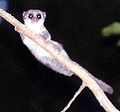 Dwarf lemurs |
 Flores Man[35] | Homo floresiensis | Flores | Extinct (Late Pleistocene) |  Homo erectus |
 Callao Man | Homo luzonensis[36][37] | Luzon, Philippines | Extinct (Late Pleistocene) | |
| Modern pygmies of Flores[38] | Homo sapiens | Flores | Extant | other members of Homo sapiens |
| Early Palau modern humans (disputed)[39] | Homo sapiens | Palau | Extinct (?) | |
| Andamanese[40] | Homo sapiens | Andaman Islands | Extant | |
 Sardinian macaque[41] | Macaca majori | Sardinia | Extinct (Pleistocene) |  Barbary macaque |
 Zanzibar red colobus | Piliocolobus kirkii | Unguja | Endangered |  Udzungwa red colobus |
| Example | Binomial name | Native range | Status | Continental relative | Insular / mainland length or mass ratio |
|---|---|---|---|---|---|
 Sicilian wolf | Canis lupus cristaldii | Sicily | Extinct (AD 1970) |  Gray wolf | |
 Japanese wolf | Canis lupus hodophilax | Japan (excluding Hokkaido) | Extinct (AD 1905) | ||
 Sardinian dhole (forward) | Cynotherium sardous | Corsica and Sardinia | Extinct (c. 8300 BC) |  Xenocyon | |
| Trinil dog | Mececyon trinilensis | Java | Extinct (Pleistocene) | ||
| Cozumel Island coati[14] | Nasua narica nelsoni | Cozumel | Critically endangered |  Yucatan white-nosed coati | |
 Zanzibar leopard | Panthera pardus pardus | Unguja | Critically endangered or Extinct |  African leopard | |
 Bali tiger | Panthera tigris sondaica | Bali | Extinct (c. AD 1940) |  Sumatran tiger | |
 Javan tiger | Java | Extinct (c. AD 1975) | |||
 Cozumel raccoon | Procyon pygmaeus | Cozumel | Critically endangered |  Common raccoon | |
 Island fox | Urocyon littoralis | Six of the Channel Islands of California | Near Threatened |  Gray fox | LR ≈ 0.84 [lower-alpha 5] LR ≈ 0.75 [lower-alpha 6] |
| Cozumel fox | Urocyon sp. | Cozumel | Critically endangered or Extinct |
| Example | Binomial name | Native range | Status | Continental relative |
|---|---|---|---|---|
 Eumaiochoerus | Eumaiochoerus etruscus | Baccinello, Montebamboli | Extinct (Miocene) |  Microstonyx |
 Malagasy dwarf hippopotamuses | Hippopotamus laloumena H. lemerlei H. madagascariensis | Madagascar | Extinct (c. AD 1000) |  Common hippopotamus |
| Bumiayu dwarf hippopotamus[26] | Hexaprotodon simplex | Bumiayu Island (now Java) | Extinct (Early Pleistocene) | 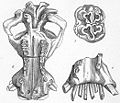 Asian hippopotamuses |
 Cretan dwarf hippopotamus | Hippopotamus creutzburgi | Crete | Extinct (Middle Pleistocene) |  Hippopotamus antiquus |
 Maltese dwarf hippopotamus | Hippopotamus melitensis | Malta | Extinct (Pleistocene) |  Common hippopotamus (H. amphibius) |
 Sicilian dwarf hippopotamus | Hippopotamus pentlandi | Sicily | Extinct (Pleistocene) | |
 Cyprus dwarf hippopotamus | Hippopotamus minor | Cyprus | Extinct (c. 8000 BC) | Unclear, either
H. amphibius or H. antiquus. |
| Cozumel collared peccary[14] | Pecari tajacu nanus | Cozumel | Unknown |  Collared peccary |
| Example | Binomial name | Native range | Status | Continental relative |
|---|---|---|---|---|
| Sicilian bison[27] | Bison priscus siciliae | Sicily | Extinct (Late Pleistocene) |  Steppe bison |
| Sicilian aurochs[44] | Bos primigenius siciliae[27] | Sicily | Extinct (Late Pleistocene) |  Eurasian aurochs |
| Cebu tamaraw | Bubalus cebuensis | Cebu, Philippines | Extinct |  Wild water buffalo |
 Lowland anoa | Bubalus depressicornis | Sulawesi and Buton, Indonesia | Endangered | |
| Bubalus grovesi | Bubalus grovesi | Sulawesi, Indonesia | Extinct | |
 Tamaraw | Bubalus mindorensis | Mindoro, Philippines | Critically endangered | |
 Mountain anoa | Bubalus quarlesi | Sulawesi and Buton, Indonesia | Endangered | |
 Balearic Islands cave goat | Myotragus balearicus | Majorca and Menorca | Extinct (after 3000 BC) | Gallogoral |
| Nesogoral[45] | Nesogoral spp. | Sardinia | Extinct | |
| Dahlak Kebir gazelle[46] | Nanger soemmerringi ssp. | Dahlak Kebir island, Eritrea | Vulnerable |  Soemmerring's gazelle |
Tyrrhenotragus | Tyrrhenotragus gracillimus | Baccinello | Extinct | Antilopinae sp. |
| Example | Binomial name | Native range | Status | Continental relative |
|---|---|---|---|---|
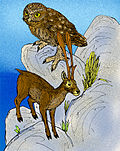 Cretan deer[lower-alpha 7] | Candiacervus spp. | Crete | Extinct (Pleistocene) | Unknown |
 Sardinian deer[10] | Praemegaceros cazioti | Sardinia | Extinct (c. 5500 BC) | Praemegaceros |
 Ryukyu dwarf deer[49] | Cervus astylodon | Ryukyu Islands | Extinct |  Sika deer (?) Cervus praenipponicus (?) |
| Jersey red deer population[50] | Cervus elaphus jerseyensis | Jersey | Extinct (Pleistocene) |  Red deer |
 Corsican red deer | Cervus elaphus corsicanus | Corsica and Sardinia | Near Threatened | |
| Sicilian red deer[27] | Cervus siciliae | Sicily | Extinct (Late Pleistocene) | |
 Hoplitomeryx[lower-alpha 8] | Hoplitomeryx spp. | Gargano Island | Extinct (Early Pliocene) |  Pecorans |
| Sicilian fallow deer | Dama carburangelensis | Sicily | Extinct (Late Pleistocene) | Fallow deer |
 Florida Key deer | Odocoileus virginianus clavium | Florida Keys | Endangered |  Virginia deer |
 Svalbard reindeer | Rangifer tarandus platyrhynchus | Svalbard | Vulnerable |  Reindeer |
 Philippine deer | Rusa marianna | Philippines | Vulnerable |  Sambar deer |
| Possible example | Binomial name | Native range | Status | Continental relative |
|---|---|---|---|---|
 Insular elephant cacti[51][52] | Pachycereus pringlei | Remote islands in the Sea of Cortez (e.g. Santa Cruz, San Pedro Mártir) | Not evaluated |  Mainland elephant cacti |
Seamless Wikipedia browsing. On steroids.
Every time you click a link to Wikipedia, Wiktionary or Wikiquote in your browser's search results, it will show the modern Wikiwand interface.
Wikiwand extension is a five stars, simple, with minimum permission required to keep your browsing private, safe and transparent.